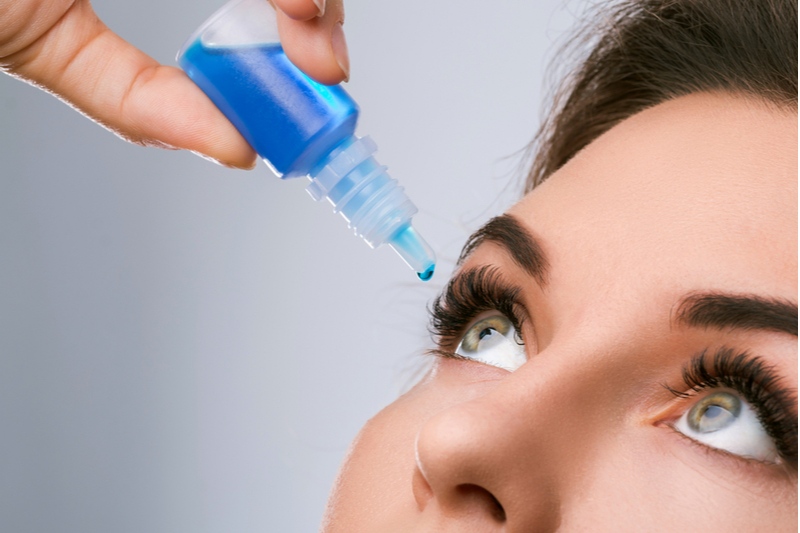Dry eye is a condition that is easily overlooked or accepted as ‘normal’, when in fact, there are numerous things that can be done to alleviate the symptoms associated with this inconvenient but fairly common ocular problem.
Dry eye occurs when patients do not have enough lubrication in the eyes to be able to move them easily and comfortably. This lubrication comes from a substance called tear film which should ideally coat the surface of the eye at all times. Although the symptoms of dry eye can be unpleasant, there are a range of treatments that can be used to relieve them and ensure your eyes remain comfortable and your vision clear.
Dry Eye Causes
There can be several different reasons why someone develops dry eye. Some of the most common causes of the condition include the following:
Your eyes aren’t making enough natural tear film
There are several glands in and around the eyelids that are responsible for tear film production. If there is a problem with the function of any of these glands, or a problem such as a blockage, they may not be able to produce enough natural tear film. Tear production also slows down with age, which makes older people more likely to suffer from the condition.
Poor quality of tear film
Contrary to what many people believe, tears aren’t just made from water. Instead, they have three different layers: water, mucus and oil. Each component plays an important role in the function of tear film, so if there is an imbalance of any kind, the lubrication that they provide may not be sufficient and the symptoms of dry eye may develop.
Your tear film doesn’t stay on the surface of the eyes for long enough
Tear film is supposed to stay on the surface of the eye for some time before it drains away using the drainage channels located in the corners of your eyes. However, some patients find that their tear film drains or evaporates too quickly, causing the eyes to dry out.
Exactly why some people develop dry eye and others don’t isn’t always identified. However, there are some factors that make you more at risk of the condition. These include:
– Being over the age of 65
– Being female, since women are more likely to develop dry eye
– Taking certain medications, including some blood pressure medications, decongestants, antidepressants and antihistamines
– Working or spending time in a particularly dry, dusty or heated environment
– Having previously undergone laser eye surgery
Symptoms of Dry Eye
So, how do you know if you have dry eye? Unsurprisingly, the most common symptom of the condition is that from which it takes its name – dry eyes. Your eyes may feel stiff and difficult to move around. However, there are also other symptoms associated with the condition, and these include:
– Redness of the eyes
– Stinging, burning and scratchy sensations
– Sensitivity to light
– Blurred vision
– Persistent eye fatigue
– Problems with glare/driving at night
– Problems with wearing contact lenses
– Excessive watering of the eye (which is the body’s way of trying to counteract the problem it is experiencing)
Dry Eye Treatment Options
Fortunately, there are numerous treatment options available that can help you to manage and control the symptoms of dry eyes, enabling you to enjoy comfortable, clear vision. Exactly which treatment will be recommended to you will largely depend on what your eye doctor believes to be the predominant cause of your dry eyes. It may also be necessary to try several options in order to find the one that suits you the best.
Some of the most effective treatments include the following:
Eye Drops. Eye drops will almost certainly be the first treatment that you are recommended to try. There are a number of different varieties available. Some are simply artificial tears, whilst others contain ingredients designed to combat dry eye, such as anti-inflammatories or steroids.
Topical Treatments. These also contain ingredients that will encourage tear film production. Topical treatments are usually gels, ointments, creams and similar types of product.
Punctual Plugs. Also known simply as plugs, these tiny devices sit inside the drainage channels of the eyes, preventing the eat film from leaving too quickly and instead, keeping it trapped on the surface of the eyes so that they feel better lubricated and more comfortable.
Lipiflow Thermal Pulsation. Lipiflow is a machine that sends warmth and vibrations to the glands responsible for tear film production in order to remove blockages and boost them to encourage more lubrication onto the eyes.
If you are concerned about dry eye, our dedicated eye health team would be happy to help. Please contact our offices to schedule an appointment for an evaluation.




